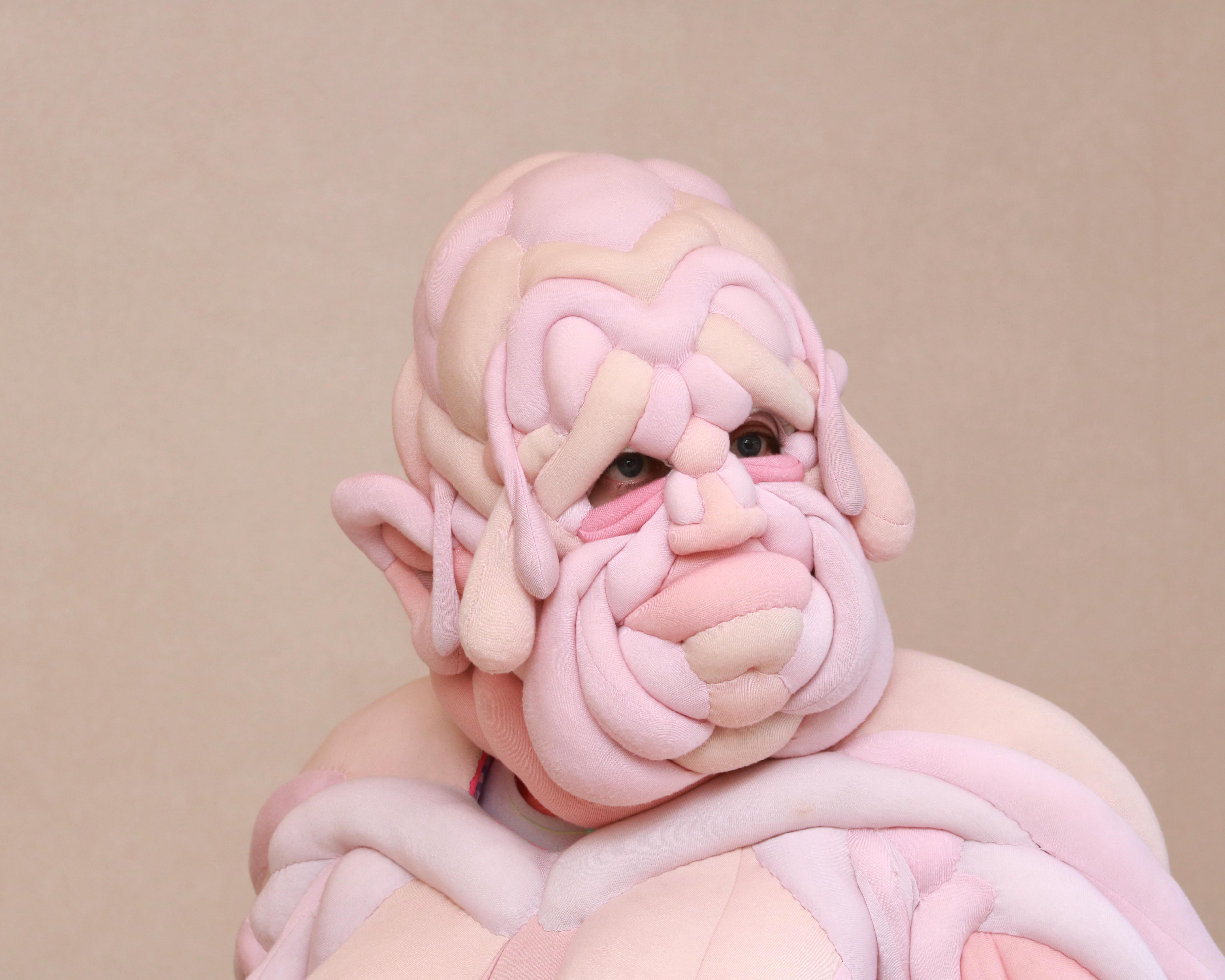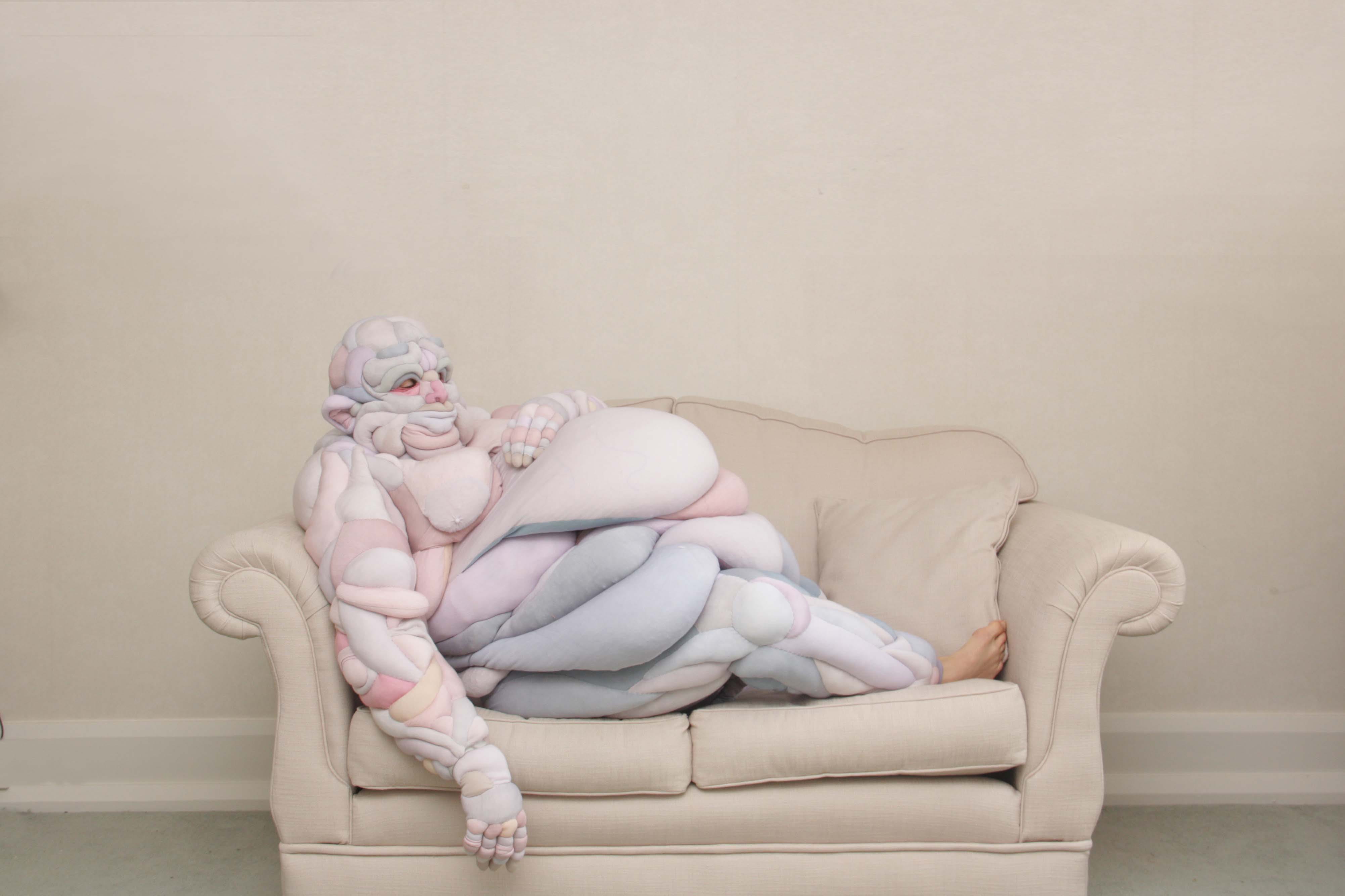DAISY COLLINGBRIDGE
@DAISY_COLLINGRIDGE
In our interview we discuss life philosophies, indulgences, future challenges and more.
Collingridge describes her work as ‘Dynamic Flesh Form’
“For me they are joyful creatures, representing the diversity of humans with a sprinkling of fantasy. They are bodily. Sculpting with fabric is more tactile, more life-like. Fabric is soft, warm and will not last forever, just like people. I have had some challenging conversations. I accept that people read the work with different eyes and different experiences. It can only be a good thing to engage in a meaningful dialogue with people. “
-
INTERVIEW
Your textiles are so bold. So recognizable and undeniable. Can you tell us a bit about the inspiration and understanding behind them?
Thankyou!
The work is a collision of science and craft; a product of my childhood. I grew up in a family of doctors, nurses and scientists. The human body has always been a subject of fascination for me. Mum took me to see Body World, by Gunther von Hagens when I was a kid. It showed the human (and other animals) in all their biological, anatomical glory preserved by plastination. I still remember this trip vividly (which is saying something as my memory is dreadful!) Combine these scientific dinner table conversations with a mum who can turn her hand to all the crafts: she can crochet, silk paint, dye, toy-make, quilt, embroider and upholster. My family home is full of fabric and threads and books on the basics of various craft. I learnt to sew as a young kid. I value the ability to hone a craft. Quilt making has been part of my practise for some time. I began using a form of free machine quilting in my graduate collection at St Martins. I see my current work as a fusion of an extreme form of quilting and an informal study of anatomy. The layered and shaped sections simultaneously mimic the relief in a quilt and the muscles of the arms or legs. I like to let the fabric itself lead me. The fabric I use is stretchy so it allows for a glorious smoothness but also has wonderful bounce when weight is added.
Could you talk to us about the process? How each of your works comes to be? Do you envisage exactly what each piece will do?
The work is labour intensive. They are mostly hand sewn, only the underlying garments are machine stitched and the fabric is all hand dyed. I’m quite an impulsive worker. I’ll have some ideas swirling around my brain, but rarely have a firm plan. I’ll start with the head, and let the character that is born determine who it is I am making. They kind of grow as I go, building up layers of wadding and fabric to create the forms. The only thing that is pre determined is the colours, as I decided early on that limited the colour palette worked better (for me). During the process of making I will consider movement, either by designing to allow for movement or by adding parts that respond to movement. Dynamism is an important part of the performance side to the work.
What do you want people to take away from your work? And have you had any memorable responses to your work that stick out?
For me they are joyful creatures, representing the diversity of humans with a sprinkling of fantasy. They are bodily. Sculpting with fabric is more tactile, more life-like. Fabric is soft, warm and will not last forever, just like people. I have had some challenging conversations. I accept that people read the work with different eyes and different experiences. It can only be a good thing to engage in a meaningful dialogue with people.
My poor little niece hates that grandpa is sometimes ‘Dave’. She will walk into the room with ‘Dave’ slumped on the sofa and ask ‘is he alive?’ She is only 3, it must be confusing!
What are the challenges or complications that come with the incredibly fleshy suit?
In terms of practical complications; the weight versus the fabric is a challenge to consider. The fabric I use is lightweight so there is always a compromise to be made. The wear and tear on fabric and stitches over time is something I have to deal with. Their imperfection and changeability is something to celebrate but at the same time I find it sad that they wont last forever!
The main complication I have come across is the controversial subject of a larger body. For me they are just bodies. All bodies should be celebrated.
How many characters do you have now for your work? And what can you tell us about each one? Are there any more planned?
There are 5 in total. I like to humanise inanimate objects. They are clear characters in their own right. It would feel wrong to just call them ‘untitled 2’. Naming them brings them to life as real individuals, which is in part what this is about; we are all unique. The first one is the prototype. I learnt the importance of colour palette whilst making her. Then there is Clive, Burt, Dave and Hillary. Burt is my favourite because of his expression and the addition of catfish- like barbells on his face. Dave is special. He was made on request for my dad. It is fascinating to watch other people inhabit them, as they bring something new to the character. There is something liberating in wearing something that covers your own identity in full.
I have made one new head in lockdown, but haven’t had the space to build the body.
How would YOU describe your work, which is part performance, in three words?Dynamic flesh form
Can you tell us a bit about your background? You’re an illustrator as well aren’t you? What drew you to textiles?
I have always drawn and made interchangeably. Currently my drawing and making practices are very different but I foresee them colliding in the future. The illustration is more of a business, where I can make a living!
During art education I would always find myself returning to fabric as my medium. I’m so comfortable with it as I have used it for so many years. My mum has been a huge influencer. She taught me how to sew and my childhood home is full of fabric and threads. Fabric is tactile and relatable. It is a material we are all so familiar with; we have it close to our skin everyday which layers the work with additional meaning.
Looking ahead, what do you think could be your biggest challenge?
I’m not sure it’s a future challenge; more an on going one. Finding balance in life is always challenging. Balancing time with family, my partner, my practice, exercise and playtime. I imagine most people will identify with that challenge.What is your greatest indulgence in life?
Being able to commit to attempting to do what I love as my job is pretty indulgent. I feel very lucky to do what makes me happy most days.
Do you have a philosophy of life? Or words you live by?You get out what you put in.

Favourite historical female artist?
Does Louise Bourgeois count as historical? She was so prolific and handled so many different mediums and subjects. A true inspiration to me.
Favourite current practicing female artist?
I have only recently discovered Bisa Butlers work and love it. Quilting is a craft that I truly respect. It often gets sidelined with the ‘crafting’ label so it’s a joy to see an artist use the craft of quilting in the art world. On that subject, I absolutely don’t think the word craft should be a dirty word in art. There should be a celebration in honing a skill, not a dismissal.Who should She Curates interview next?
I have been listened to Kate Tempest on repeat recently. I would always read her words.

